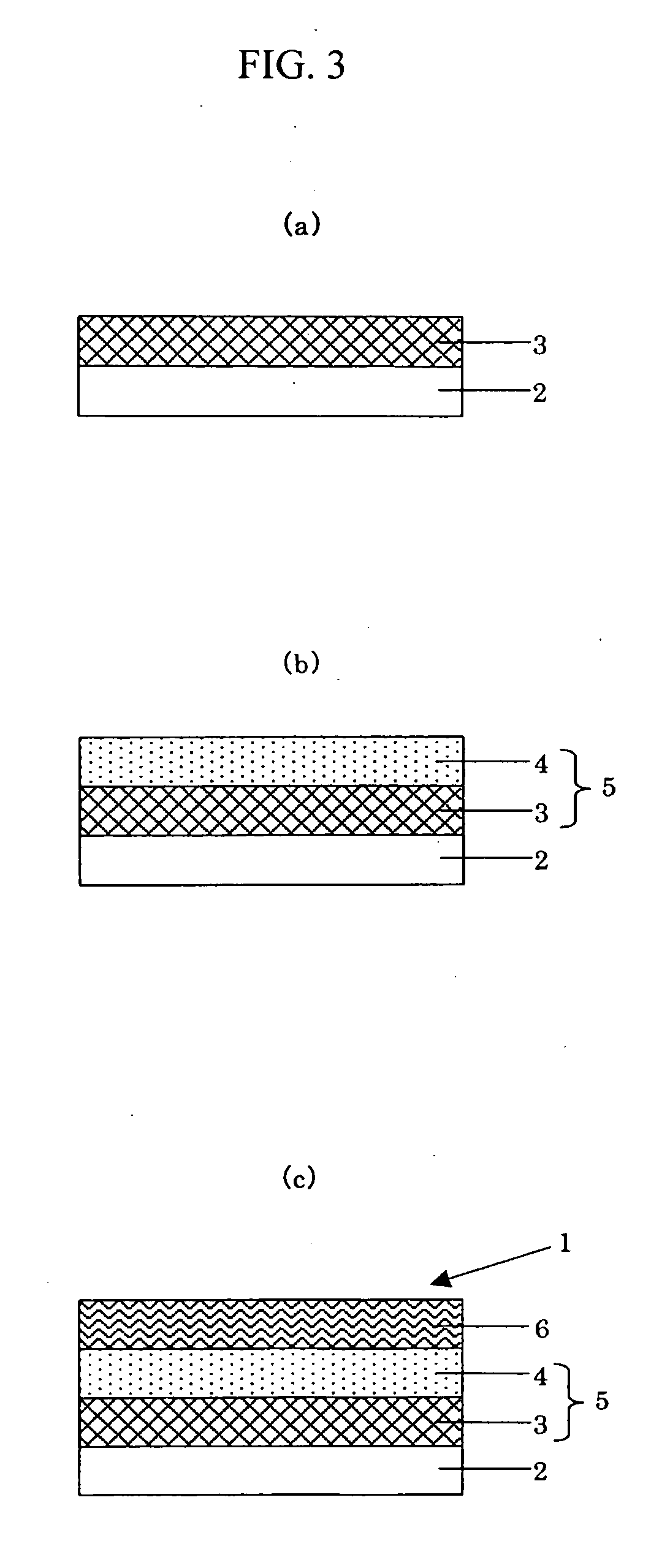Photomask blank, photomask, and pattern transfer method using photomask
a pattern transfer and photomask technology, applied in the field of photomask blanks, photomasks, and pattern transfer methods using photomasks, can solve the problems of further seriousness, reduced pattern transfer accuracy, and increased difficulty in achieving pattern transfer
- Summary
- Abstract
- Description
- Claims
- Application Information
AI Technical Summary
Benefits of technology
Problems solved by technology
Method used
Image
Examples
embodiment 1
[0043] As shown in FIG. 1, in a photomask blank 1 according to Embodiment 1, a quartz glass substrate having both main surfaces and end surfaces subjected to precision polishing and a size of 6 inches×6 inches×0.25 inch is used as a translucent substrate 2.
[0044] On the translucent substrate 2, a Cr film of 500 angstrom is formed as a light-shielding film 3, a CrO (which means that chrome and oxygen are contained but does not specify content rates of these materials, and this is also applied to the following) film of 180 angstrom is formed as a reflection factor reducing film 4 and an MoSiON film of 100 angstrom is formed as an antireflective film 6.
[0045]FIG. 2 is a cross-sectional view showing a photomask according to Embodiment 1. This photomask 11 is formed by sequentially patterning the antireflective film 6, the reflection factor reducing film 4 and the light-shielding film 3 from an upper layer portion of the photomask blank 1.
[0046] A manufacturing method of the photomask...
embodiment 2
[0058] First, a translucent substrate 2 having a size of 6 inches×6 inches×0.25 inch obtained by subjecting main surfaces and end surfaces (side surfaces) of a quartz substrate to precision polishing was used, and a CrC film as a light-shielding film (layer) 3 was formed by reactive sputtering of an inline type sputtering apparatus using a Cr target in a mixed gas atmosphere of Ar and CH4 (Ar: 96.5 volume %, CH4: 3.5 volume %, and a pressure: 0.3 [Pa]).
[0059] Then, a CrON film as a reflection factor reducing film (layer) 4 was formed on the light-shielding film (layer) by reactive sputtering of the same inline type sputtering apparatus using a Cr target in a mixed gas atmosphere of Ar and NO (Ar: 87.5 volume %, NO: 12.5 volume %, a pressure: 0.3 [Pa]). Here, formation of the CrON film was carried out continuously with formation of the CrC film, and a total film thickness of the CrON film and the CrC film was 800 angstrom. This corresponds to a case where a boundary between the ligh...
embodiment 3
[0063] First, a quartz glass substrate having both main surfaces and end portions subjected to precision polishing and a size of 6 inches×6 inches×0.25 inch is used as a translucent substrate 2, then a CrC film (layer) as a light-shielding film 3 and a CrON film as a reflection factor reducing film (layer) 4 are continuously formed, and these steps are the same as those in Embodiment 2.
[0064] Subsequently, an MoSiON film having a film thickness of 100 angstrom was formed as an antireflective film 6 by reactive sputtering of a sheet type sputtering apparatus using an MoSi (Mo: 10 atom %, and Si: 90 atom %) target in a mixed gas atmosphere of Ar, N2 and O2 (Ar: 25 volume %, N2: 65 volume %, O2: 10 volume %, and a pressure: 0.13 [Pa]). Thereafter, scrub cleansing was performed to obtain a photomask blank 1.
[0065] Here, a transmission factor of the 100-angstrom MoSiON film used as the antireflective film was 91.7% in 248 nm and 86.7% in 193 nm like Embodiment 1 (however, a transmissio...
PUM
| Property | Measurement | Unit |
|---|---|---|
| wavelength | aaaaa | aaaaa |
| wavelength | aaaaa | aaaaa |
| wavelength | aaaaa | aaaaa |
Abstract
Description
Claims
Application Information
 Login to View More
Login to View More - R&D
- Intellectual Property
- Life Sciences
- Materials
- Tech Scout
- Unparalleled Data Quality
- Higher Quality Content
- 60% Fewer Hallucinations
Browse by: Latest US Patents, China's latest patents, Technical Efficacy Thesaurus, Application Domain, Technology Topic, Popular Technical Reports.
© 2025 PatSnap. All rights reserved.Legal|Privacy policy|Modern Slavery Act Transparency Statement|Sitemap|About US| Contact US: help@patsnap.com



